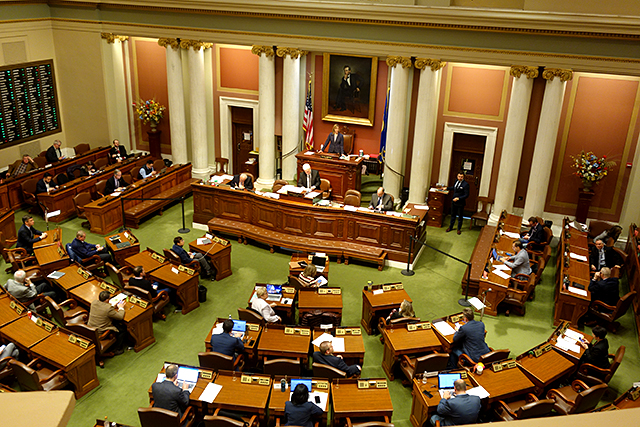
[image_credit]MinnPost photo by Peter Callaghan[/image_credit][image_caption]As part of the third COVID-19 response bill passed in a one-day session on March 26, the Minnesota Legislature created the COVID-19 Minnesota Fund.[/image_caption]
To isolate the infected and get the healthy back to work, Minnesota needed the capacity to do 5,000 tests a day, Walz said. But conducting the number of virus tests a day and antibody tests the U and Mayo were talking about would require $20 million each.
Some in the Legislature moved to support the request for funding, either through direct grants or tax credits. But it turns out lawmakers didn’t have to do anything — because they’d already done so.
As part of the third COVID-19 response bill passed in a one-day session on March 26, the Legislature created the COVID-19 Minnesota Fund, and seeded it $200 million, the bulk of the $330 million in COVID-19 response money appropriated that day.
The money could be spent to “protect Minnesota citizens from the COVID-19 outbreak, and maintain state government operations throughout the duration of the peacetime emergency” — a definition broad enough to include the testing money.
7.4 million surgical masks, 150,000 face shields, 12 million gloves
Because it was to pay for COVID-related costs that weren’t yet known, when Walz originally asked for the fund last month he also sought permission to spend it as he saw fit. While lawmakers weren’t willing to do all of that, the bill did set up a new way of exercising the Legislature’s constitutional authority to appropriate money, creating a 10-member Legislative COVID-19 Response Commission.
Here’s how it works: When state Office of Management and Budget Commissioner Myron Frans wants to spend more than a million dollars at a time, he emails the members of the response commission outlining the request. Unless three House members and three Senate members respond in the negative within 24 hours, the money can be spent. No response is considered a yes vote.
So far, Frans has made eight requests of more than $1 million and made 24 other withdrawals of less than $1 million, for a total of $76.2 million. The only negative vote from the 10 legislators came from House Minority Leader Kurt Daudt on an April 9 request for $2.255 million to “manage COVID-19 related demand” in the state’s prisons.

[image_credit]Minnesota Management and Budget[/image_credit]
The most-recent request made April 13 was for $42 million for the “purchase of critical supply needs.” Previous appropriations allowed money to be sent directly to hospitals and other healthcare providers to cover expenses for staffing, facilities and equipment to treat COVID-19 patients.
A desire for the Legislature to be involved
At his press briefing Friday, Walz said he was excited about the U of M/Mayo proposal and said he has spoken with legislative leaders, including Senate Majority Leader Paul Gazelka, about the plan.
“We are very much aligned on this idea of trying to get this testing done,” Walz said. “Our partners have stepped up on this. It was my goal to be testing everybody we should be tested. I think with their capacity, Minnesota is the example of what we can do.”
As for the money, Walz said: “We think the COVID-19 Fund that the Legislature gave us would be the place to start with this. I think there’s a desire for the Legislature to be deeply involved.”

[image_credit]Christine T. Nguyen/MPR News via AP, Pool[/image_credit][image_caption]At his press briefing Friday, Gov. Tim Walz said he was excited about the U of M/Mayo proposal[/image_caption]
Under the law passed last month, any money not authorized to be spent by May 11 reverts to the state general fund, unless the Legislature extends the deadline.
The original Walz request did not contain the legislative commission — nor a deadline for appropriations. Both were added in negotiations with legislative leaders.
“We still needed to provide the governor the capability to be very quick on his feet and nimble with getting the money out there,” said Rosen. “We wanted to make sure we had the ability to say no.”
“It’s worked very well,” she said. “We’ve been able to respond to his requests in a very expedient fashion.”
For the Legislature, the bigger issue is the money already flowing to the state from the federal CARES Act. The state is expected to receive more than $3 billion under the bill, with more likely coming in subsequent aid to the states.
Rosen wants the Legislature to have a significant role in appropriating that money as well. “Hopefully the governor understands the importance of keeping the Legislature involved,” Rosen said. “We’re not saying that the governor can’t have an emergency fund that he can be quite nimble if he burns through this first $200 million.”




